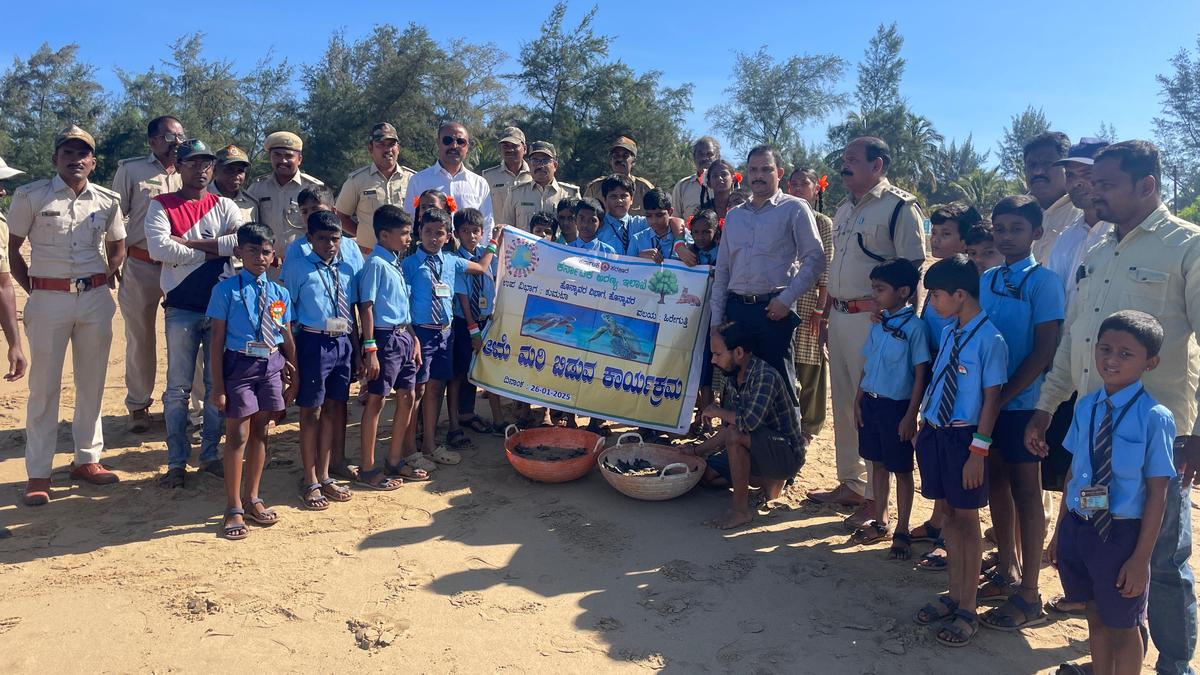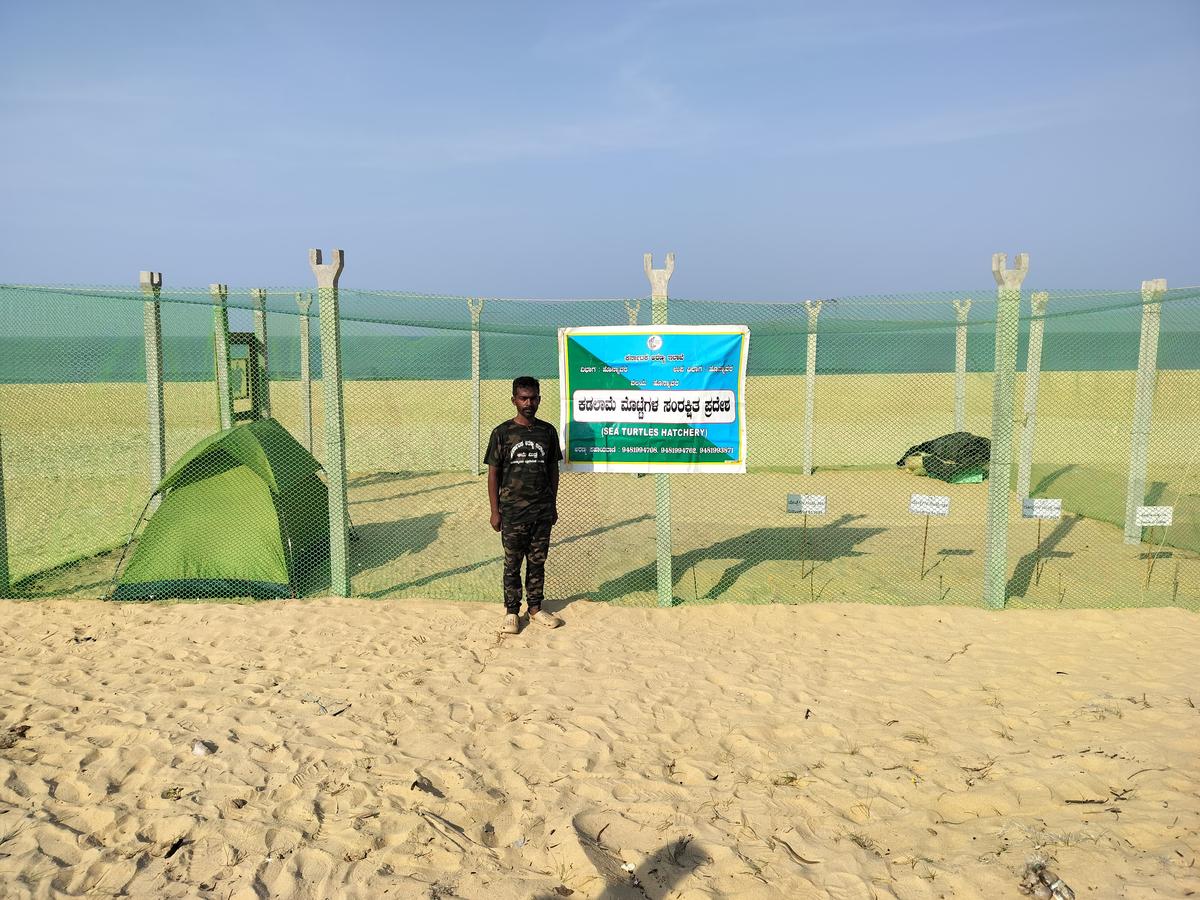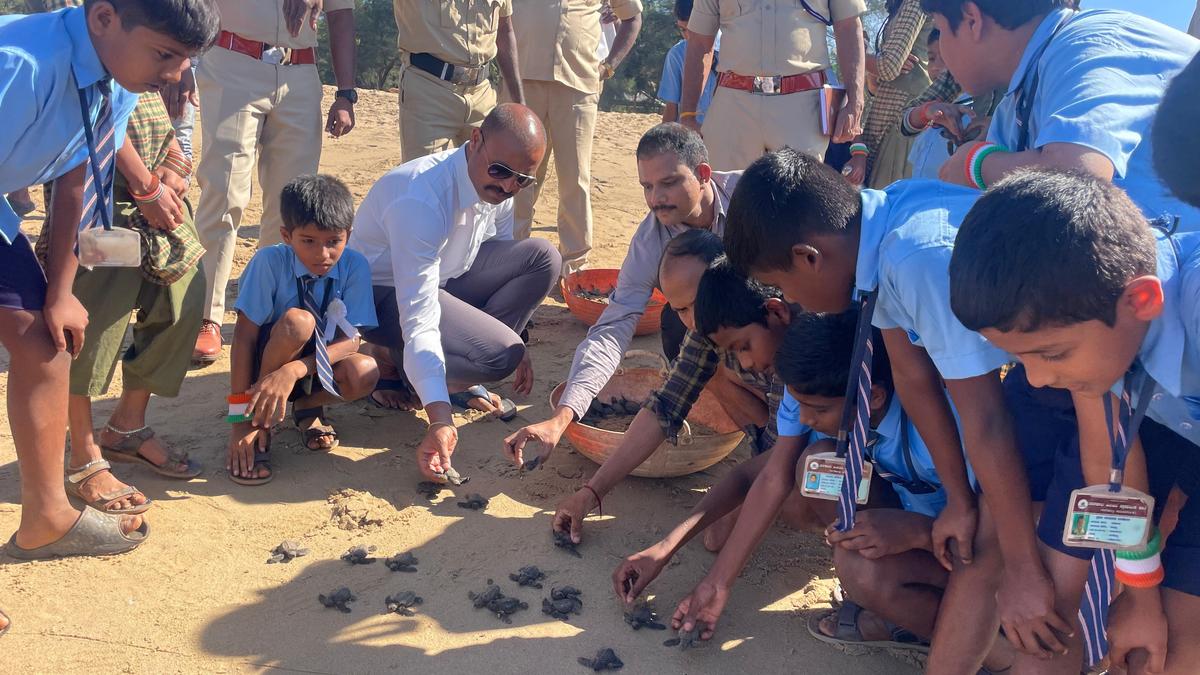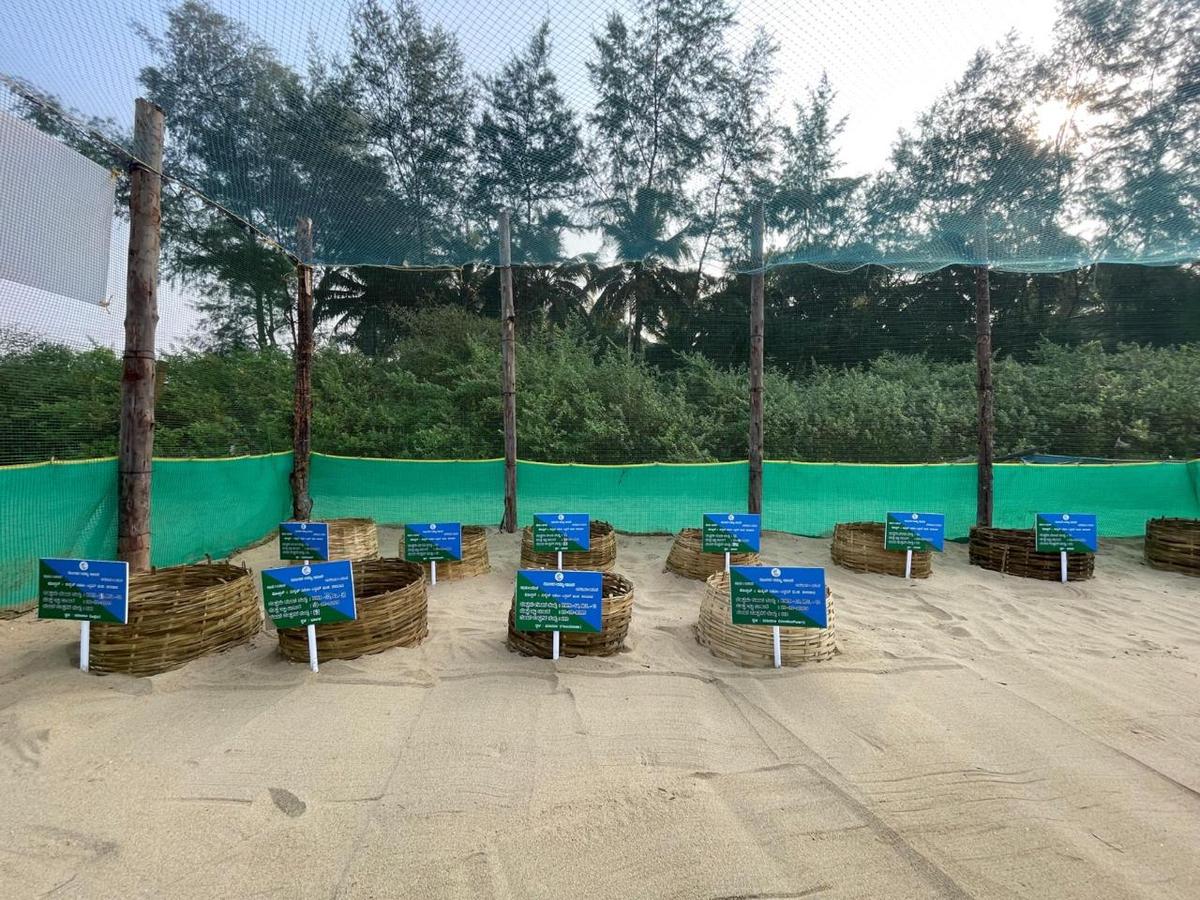It is turtle time in coastal Karnataka with hundreds of sea turtles, mainly the Olive Ridleys, flocking to the beaches to lay eggs during December-March. There are also efforts to safeguard them so as to ensure the turtle offspring return to the sea after a gap of 45-60 days.
Though the sea turtles take abundant precaution in choosing their nesting sites by arriving on beaches during full moon high-tides and digging nests for a depth of up to 1.5 ft as far as away from the high-tide line, eggs so laid are often devoured by predators, including stray dogs. And sometimes by human beings too.
Forest department personnel and volunteers remove turtle eggs from a nest to an artificial hatching centre to protect them from high tide and dogs at Sasihithlu Beach near Mangaluru.
| Photo Credit:
SPECIAL ARRAGEMENT
With increasing awareness among people, several initiatives of the government through the Forest Department and legal framework for turtle protection, turtle conservation, protection of their eggs and safe release of the hatchlings are getting institutionalised across the country in general and Karnataka coast in particular.
All five species of marine turtles found in Indian waters—the Olive Ridley (Lepidochelys Olivacea), Green (Chelonia Mydas), Hawksbill (Eretmochelys imbricata), Leatherback (Dermochelys Coriacea) and Loggerhead (Caretta caretta) — are protected under Schedule I of the Wildlife (Protection) Act, 1972.
While Olive Ridleys visit the Karnataka coast in large numbers, a few Green turtles too are rare visitors, according to forest department officials.

The Forest department involving students and general public during an event that showcased how to release Olive Ridley hatchlings to the Sea in the Hiregutthi range, Honnavar taluk.
| Photo Credit:
SPECIAL ARRAGEMENT
From 2020 onwards
Officials said after 1985-86, sea turtle nesting was not predominantly noticed along the Karnataka coast till about 2020-2021, from which period sporadic instances of turtle nesting were being witnessed on the beaches of the three coastal districts. The Union Ministry of Environment, Forest and Climate Change (MoEFCC) also came out with the National Marine Turtle Action Plan in 2021 listing out dos and don’ts with regard to turtle conservation.
The Plan said, “Marine turtles play a variety of ecological roles for maintaining healthy marine habitats like controlling prey populations, supporting coastal vegetation through their hatchlings etc. Their presence is an indicator of healthy marine ecosystems and provides a source of revenue for local communities through tourism. Marine turtles thus present themselves as a key indicator of healthy marine habitats and an opportunity for conservation of associated species.”
It set five goals in the action plan that included conserving the species, their habitat and reduce negative impacts on survival of marine turtles; improving the understanding of marine turtles and their habitats through a coordinated mechanism; promoting awareness and education on their conservation; enhancing livelihoods of coastal communities through promoting sustainable ecotourism and increasing national, regional and international cooperation on marine turtle conservation.

Forest department builds artificial hatching centres to ensure sea turtle eggs are protected from the high tide.
| Photo Credit:
SPECIAL ARRAGEMENT
Highest in Uttara Kannada
Though turtle nesting sites, mainly of Olive Ridleys, are found all along the 320-odd km Karnataka coastline, Uttara Kannada district, particularly the Honnavar Forest Division, records the highest number of nests as well as hatchlings. From the South, nesting sites could be found in Bengre, Panambur, Idya and Sasihithlu in Dakshina Kannada Division, Hejmady, Padubidri, Parampalli, Kundapur-Kodi, Tarapathy, Maravanthe and Koderi in Kundapur Division, Haldipur, Honnavar, Dhareshwar and Gangavali Beach in Honnavar Division, Manjuguni, Belamber, shedkuli, Bhavikeri, Harwada, Mudaga, Naval Base, Tagore Beach, Devbagh, Bavala and Majali in Uttara Kannada Division.
Honnavar Deputy Conservator of Forests (DCF) C.K. Yogeesh said sporadic nesting is found all along the coastline in the Division while high concentration is found in the four places.
The nesting season normally begins in December and goes on till about March while the hatchlings come out 45-60 days after the nesting. In Dakshina Kannada forest division, 1,214 hatchlings are so far released this year from 14 nests out of 24 total nests while in the Kundapur division, 1,127 hatchlings are released from 19 sites out of total 25 sites. Honnavar forest division saw the highest number of eggs (33,731) in 344 sites and hatchlings released (18,000 odd so far) while about 4,500 hatchlings are so far released from 56 sites out of 119 total nesting sites in Karwar division.

Kundapur DCF K. Ganapathy said the department has taken many initiatives, including involving fishermen and NGOs in the turtle conservation initiative along the 98 km beach stretch under the Division.
| Photo Credit:
SPECIAL ARRAGEMENT
Involving the public
The mission to conserve marine turtles becomes successful only when the public residing closer to beaches, particularly the fishermen and women, are involved, said Karwar Division DCF R. Ravishankar. While the fisherfolk who revere turtles do not harm them, enhanced awareness among them and other people, cooperation from civil society organisations etc., has extensively helped the department in the conservation mission.
The department follows both in-situ (on-site) and ex-situ (off-site) conservation models. If the in-situ site where the eggs in nests are found to be in danger of either being washed away or devoured by predators, they shift the eggs to specially created ex-situ sites; in both the instances, fencing would be done for protection. Cash incentives are provided to fishermen on intimating about nesting, Ravishankar added.
Kundapur DCF K. Ganapathy said the department has taken many initiatives, including involving fishermen and NGOs in the turtle conservation initiative along the 98 km beach stretch under the Division. ReefWatch Marine Conservation-Kundapur, National Service Scheme volunteers, college students and local people are involved in beach cleaning and turtle conservation initiative, he said. All the four Divisions in the coast have Coastal and Marine Ecosystem Cells specifically mandated to conserve various marine species, including the turtles.

Forest department officials and volunteers release sea turtle hatchlings to the Arabian Sea early in morning in Karwar division.
| Photo Credit:
SPECIAL ARRAGEMENT
Not a routine job
Manoj Sona, Range Forest Officer with Dakshina Kannada Marine Cell, said turtle conservation is not just another job for the department personnel; but they do it with passion. Forest watchers, along with volunteers and students, conduct night patrolling to ensure that predators do not destroy the eggs in the nest.
While they follow the flipper marks of adult turtles on beaches to locate the nests, the adult turtles often create multiple flipper mark tracks to misguide others, particularly the predators. The personnel closely follow the marks to zero in on the actual nesting sites, he said. Both in-situ and ex-situ nesting sites are provided with CCTV cameras for round-the-clock monitoring, he added.

The forest department has created an artificial hatchery to protect sea turtle eggs, grouping them date-wise near Karwar.
| Photo Credit:
SPECIAL ARRAGEMENT
Keeping close watch
The personnel keep close watch on the nests, particularly after 45 days of the nest formation. When the eggs hatch, the nests slightly shrink through which the department gets to know hatchlings would soon come out. Like any other animal, hatchlings too follow the light when they come out of the nest after sunset and before sunrise and often tend to get misguided by electric lights in their vicinity.
To prevent this, personnel sometimes create a safe passage from the nest towards the sea and guide the hatchlings with a torchlight. The hatchlings can survive for 48 hours after coming out before which time they should enter the deep sea and find food on their own, Sona added. The RFO further said it was observed that the hatchlings would return to the same place to lay eggs when they grow adult.
Published – April 04, 2025 09:00 am IST
